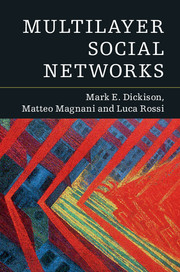Book contents
- Frontmatter
- Dedication
- Contents
- list of abbreviations
- 1 Moving Out of Flatland
- PART I MODELS AND MEASURES
- PART II MINING MULTILAYER NETWORKS
- 4 Data Collection and Preprocessing
- 5 Visualizing Multilayer Networks
- 6 Community Detection
- 7 Edge Patterns
- PART III DYNAMICAL PROCESSES
- PART IV CONCLUSION
- Glossary
- Bibliography
- Index
6 - Community Detection
from PART II - MINING MULTILAYER NETWORKS
Published online by Cambridge University Press: 05 July 2016
- Frontmatter
- Dedication
- Contents
- list of abbreviations
- 1 Moving Out of Flatland
- PART I MODELS AND MEASURES
- PART II MINING MULTILAYER NETWORKS
- 4 Data Collection and Preprocessing
- 5 Visualizing Multilayer Networks
- 6 Community Detection
- 7 Edge Patterns
- PART III DYNAMICAL PROCESSES
- PART IV CONCLUSION
- Glossary
- Bibliography
- Index
Summary
The Configuration of the Circles, to which all other objects are subordinated.
– The SquareSNA is at least as much about connections within groups of individuals highly connected to each other as it is about connections between two actors. As Kadushin (2012) has suggested, as soon as we move beyond a dyadic perspective, we can see how the role played within larger social contexts by groups of actors, their sense of belonging, and the social support those groups can provide are among the main focuses of SNA.
The apparently simple fact that social networks contain subregions that are densely connected has consequences both at an actor level and at a network level. Tightly connected subregions have an impact at an actor level when we observe how actors with common attributes are often connected together, and they have a direct impact on network dynamics when we observe how they influence phenomena like the speed of information propagation. Communities, with their intermediate nature connecting individual actors’ social experience with larger network dynamics, play a central role within any sociological theory that tries to understand how human societies evolved from small mechanic groups, that is, from homogeneous individuals connected because of their similarities, toward more complex organic societies, characterized by an interdependent set of complementary groups or individuals, still maintaining a necessary level of internal support and solidarity (Tonnies, 1957).
The study of these intermediate structures between the individual and the societal level has a long tradition. Community is a frequently used term to indicate these structures, despite the fact that this term carries connotations of sociological aspects that are not always observable within the structural perspective of SNA (Bernard, 2012). SNA scholars have often used the term cohesive subgroup to refer to a related concept stressing its structural perspective, and at the same time, computer scientists have often referred to the same idea with the term cluster. Within this chapter, we try to provide a common framework for the community detection task on multilayer networks, without changing, when possible, the original terms connected with the concepts we are describing.
- Type
- Chapter
- Information
- Multilayer Social Networks , pp. 96 - 118Publisher: Cambridge University PressPrint publication year: 2016



